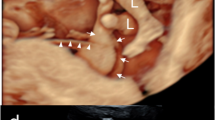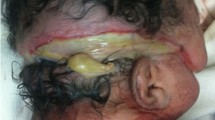Abstract
Amniotic band syndrome (ABS) has been known since ancient times. Descriptions in modern medicine have occurred since the mid-nineteenth century. The association of the amniotic band syndrome with tethered cord is rare. It was generally thought to be incompatible with life. Of late, with better imaging, there have been case reports of amniotic bands causing cord tethering in neurosurgical literature, but its association with limited dorsal myeloschisis has hitherto not been described. We report a case of amniotic band syndrome (ABS) associated with a cervical limited dorsal myeloschisis (LDM) in a child of 2 and a half years old. The management of LDM in ABS is essentially the same as in isolated cases







Similar content being viewed by others
References
Bamforth JS (1992) Amniotic band sequence: Streeter’s hypothesis re-examined. Am J Med Genetics 44(3):280–287
Matic A, Comazec J (2009) Amniotic band syndrome. Acta Medica Medianae 48(2):44–48
Walter JH Jr, Goss LR, Lazzara AT (1998) Amniotic band syndrome. J Foot Ankle Surg 37:325–333
Bower C, Norwood F, Knowles S (1993) Amniotic band syndrome: a population based study in two Australian states. Paediatric and Perinatal Epidemiology 7(4):395–403
Poeuf B, Samson P, Magalon G (2008) Amniotic band syndrome. Chir Main 27(Suppl.1):S136–S147
Moreman P, Fryns JP, Vandenberghe K, Lauweryns JM (1992) Constrictive amniotic bands, amniotic adhesions and limb–body wall complex: discrete disruption sequences with pathogenetic overlap. Am J Med Genet 42:470–479
Light TR, Ogden JA (1993) Congenital constriction band syndrome. Pathophysiology and treatment. The Yale Journal of Biology and Medicine 66:143–155
Torpin R (1968) Fetal malformations caused by amnion rupture during gestation. Charles C Thomas publisher, Springfield, pp 1–76
Lockwood C, Ghidini A, Romero R, Hobbins JC (1989) Amniotic band syndrome: re-evaluation of its pathogenesis. Am J Obstet Gynecol 160:1030–1033
Ross MG (2007) Pathogenesis of ABS. Am J Obst Gynaec 197(2):219–220
Bourne MH, Klassen RA (1987) Congenital annular constricting bands: review of literature and a case report. Journal of Pediatric Orthopedics 7(2):218–221
Robin NH, Franklin J, Prucka S, Ryan AB, Grant JH (2005) Clefting, amniotic bands and polydactyly: a distinct phenotype that supports an intrinsic mechanism for ABS. Am J of Med Genetics Part A 137A(3):298–301
Lateo SA, Taylor AE, Meggitt SJ (2006) Raised limb bands developing in infancy. Br J Dermat 154(4):791–792
Wiedrich TA (1998) Congenital constriction band syndrome. Hand Clinics 14(1):29–38
Jabor MA, Cronin ED (2000) Bilateral cleft lip and cleft palate and limb deformities: a presentation of ABS? J Craniofacial surgery 11(4):388–393
Ito M, Onitsuka Y, Matsui K, Fujisaki S, Maeyama M (1986) Craniofacial defects associated with amniotic band syndrome: a case report. Int J Gynaecol Obstet 24(1):43–45
Werler MM, Louik C, Mitchell AA (2003) Epidemiological analysis of maternal factors and amniotic band defects. Birth Defects Res A clin Mol Teratol 67(1):68–72
Brent RL (2004) Environmental causes of human congenital malformations: the paediatric role in dealing with these complex clinical problems caused by a multiplicity of environmental and genetic factors. Pediatrics 113(4Suppl):57–68
Kanit H, Aslan D, Dicle N, Ugurel G (2001) Amniotic band syndrome after cervical circlage. Perinatoloji Dergisi 50(2):156–158
Webster WS, Lipson AH, Brown-Woodman PD (1987) Uterine trauma and limb defects. Teratology 35(2):253–260
Burk CJ, Aber C, Connelly EA (2007) Ehlers-Danlos syndrome (Type IV): keloidal plaques of lower extremities, amniotic band limb deformity and a new mutation. J Am Acad Dermatol 56(2-suppl):S53–S54
Kroes HY, Pals G, van Essesn AJ (2003) Ehlers-Danlos syndrome type IV: unusual congenital anomalies in a mother and son with a COL3A1 mutation and a normal COL III protein profile. Clin Genet 63(3):224–227
Kino Y (1987) Clinical and experimental studies of the congenital constriction band syndrome, with an emphasis on its etiology. J Bone Joint Surg 57A:636
Kawamura K, Chung KC (2009) Constriction band syndrome. Hand Clin 25:257–264
Allington NJ, Kumar SJ, Guille JT (1995) Clubfeet associated with congenital constriction bands of the ipsilateral lower extremity. Journal of Pediatric Orthopedics 15(5):599–603
Fathallah ZF (2007) Unusual presentation of ABS. Bas J Surg 11:77–79
Yamanouchi H, Ota T, Imataka G, Hagiwara Y, Nakagawa E, Eguchi M (2002) Congenital bilateral perisylvian syndrome associated with congenital constriction band syndrome. J Child Neurol 17(6):448–450
Merrimen JL, McNeely PD, Bendor-Samuel RL, Schmidt MH, Fraser RB (2006) Cong placental-cerebral adhesion: an unusual case of ABS. JNS 104(5 Suppl):352–355
Urich H, Herrick MK (1985) The amniotic band syndrome as a cause of anencephaly. Report of a case. Acta Neuropathol. 67(3-4):190–194
Cincore V, Ninios AP, Pavlik J, Hsu CD (2003) Prenatal diagnosis of acrania associated with amniotic band syndrome. Obstet Gynecol 102:1176–1178
Pillai U, Ray K, Garg A (2010) Isolated cranial distortion mimicking caput succedenum from amniotic band disruption without any neurological abnormality. BMJ Case Rep 18
Evans C, Marton T, Rutter S, Anumba DO, Whitby EH, Cohen MC (2009) Cranial vault defects: the description of 3cases that illustrate a spectrum of anomalies. Paed Dev Path 12(2):96–102
Kutlu Dilek TU, Yazici G, Gulhan S, Polat A, Dilek B, Dilek S (2005) ABS associated with cranial defects and ectopia cordis: a report of 2 cases. J Turkish German Gynaec Assoc 6(4):308–310
Quintero RA, Morales WJ, Phillips J, Kalter CS, Angel JL (1997) In utero lysis of amniotic bands. Ultrasound Obstet Gynecol 10(5):316–320
Soldado F, Aguirre M, Peiro JL, Carreras E, Arevalo S, Fontecha CG, Velez R, Barber I, Martinez-Ibanez V (2009) Fetoscopic release of extremity amniotic band with risk of amputation. J Pediatr Orthop 29:290–293
Prabhu VC, Tomita T (1999) Spinal cord tethering associated with amniotic band syndrome. Pediatric Neurosurgery 31(4):177–182
Pettorini B, Abbas N, Magdum S (2010) Amniotic band syndrome with tethering of the spinal cord: a case-based update. Child s Nervous System 27(2):211–214
Jackson T (2001) Open thoracic meningocele associated with amniotic band syndrome. Pediatr Neurosurg 34:252–254
Eren E, Buyukyavuz I, Ayata A (2010) Amniotic band syndrome associated with sacral meningocele and anal atresia. Pediatrics International 52(3):505–506
Mohamed MA, Abdurehman P, Jose J (2008) A case of tethered cord associated with amniotic band syndrome. J Assoc Physicians India 56:1000
Pang D, Zovickian J, Oviedo A, Moes GD (2010) Limited dorsal myeloschisis: a distinctive clinicopathological entity. Neurosurgery 67:1555–1580
Isaac Newton (1726) Philosophiae Naturalis Principia Mathematica, General Scholium. 3rd edition, p 943 of I. Bernard Cohen and Anne Whitman's 1999 translation, University of California Press ISBN 0-520-08817-4. 974pg.
Author information
Authors and Affiliations
Corresponding author
Ethics declarations
Conflict of interest
The authors declare that they have no conflict of interest.
Additional information
Publisher’s note
Springer Nature remains neutral with regard to jurisdictional claims in published maps and institutional affiliations.
Rights and permissions
About this article
Cite this article
Chatterjee, S., Rao, K.S.M. & Nadkarni, A. Amniotic band syndrome associated with limited dorsal myeloschisis: a case report of an unusual case and review of the literature. Childs Nerv Syst 37, 707–713 (2021). https://doi.org/10.1007/s00381-020-04713-4
Received:
Accepted:
Published:
Issue Date:
DOI: https://doi.org/10.1007/s00381-020-04713-4




